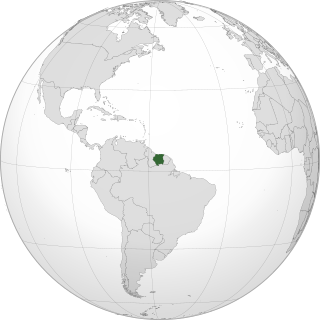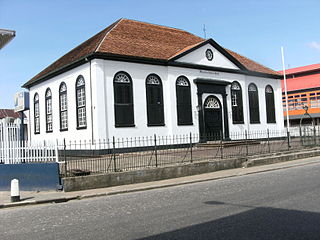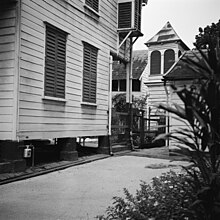
Suriname, officially the Republic of Suriname, is a country in northern South America. It is bordered by the Atlantic Ocean to the north, French Guiana to the east, Guyana to the west, and Brazil to the south. At just under 165,000 square kilometers, it is the smallest sovereign state in South America.

Paramaribo is the capital and largest city of Suriname, located on the banks of the Suriname River in the Paramaribo District. Paramaribo has a population of roughly 241,000 people, almost half of Suriname's population. The historic inner city of Paramaribo has been a UNESCO World Heritage Site since 2002.
The Kwinti are a Maroon people, descendants of runaway African slaves, living in the forested interior of Suriname on the bank of the Coppename River, and the eponymous term for their language, which has fewer than 300 speakers. Their language is an English-based creole with Dutch, Portuguese and other influences. It is similar to the languages spoken by the Aluku and Paramaccan Maroons, and split from Sranan Tongo in the middle 18th century. The Kwinti had a population of about 300 in 2014 and adhere to the Moravian Church.

Jodensavanne was a Jewish plantation community in Suriname, South America, and was for a time the centre of Jewish life in the colony. It was established in the 1600s by Sephardi Jews and became more developed and wealthy after a group of Jews fleeing persecution in Brazil settled there in the 1660s. It was located in what is now Para District, about 50 km (31 mi) south of the capital Paramaribo, on the Suriname River. Sugarcane plantations were established and Black African people were used as slave labour. At its height in around 1700 it was home to roughly 500 plantation owners and 9000 slaves. The colony faced regular attacks from Indigenous people, slave revolts, and even raids from the French navy. The community eventually relocated to the capital of Paramaribo. Clearing of grave sites and maintenance of the synagogue ruins has been attempted at various times from the 1940s to the 21st century.
Johannes Alabi (c. 1743–1820) was granman of the Saramaccans, a Maroon people in Suriname. He was of Yoruba West African descent.

Petrus Norbertus Donders was a Dutch Roman Catholic priest and member of the Redemptorist Congregation. He served in various missions in the Dutch colony of Surinam. He started working in the capital Paramaribo, but is predominantly known for his work in and around the leper colony Batavia, where he died in 1887. Peter Donders was beatified as 'Apostle of the Indians and Lepers' in 1982. The miracle needed was found in the cure of a Dutch child from bone cancer back in 1929.

Beekhuizen is a former sugarcane plantation and currently a resort in Suriname, located in the Paramaribo District. Its population at the 2012 census was 17,185.

Centrum is a resort in Suriname, located in the Paramaribo District. Its population at the 2012 census was 20,631. The historical centre of Paramaribo is located within the resort. The city centre is mainly in original condition, contains 291 listed monuments, and has of 2002 been designated a Unesco World Heritage Site.

The Cathedral-Basilica of Saint Peter and Paul also called Saint Peter and Paul Cathedral is a wooden Roman Catholic cathedral located in the centre of the capital city of Paramaribo, Suriname.

The Ndyuka people or Aukan people (Okanisi), are one of six Maroon peoples in the Republic of Suriname and one of the Maroon peoples in French Guiana. The Aukan or Ndyuka speak the Ndyuka language. They are subdivided into the Opu, who live upstream of the Tapanahony River in the Tapanahony resort of southeastern Suriname, and the Bilo, who live downstream of that river in Marowijne District

The history of the Jews in Suriname starts in 1639, as the English government allowed Spanish and Portuguese Jews from the Netherlands, Portugal and Italy to settle the region, coming to the old capital Torarica.

MariaLobach Hartmann was a German-born Moravian missionary in Suriname.

Berg en Dal is a village in the resort of Klaaskreek in the Brokopondo District of Suriname. The village is located on the Suriname River.

Johannes King, was the first Maroon missionary, and the first important writer in Sranan Tongo. King belonged to the Matawai tribe, and performed his missionary activities for the Moravian Church.

Centrumkerk is a church of the Dutch Reformed Church of Suriname. It is located on Kerkplein in the centre of Paramaribo. It was the State church until independence of Suriname in 1975. The Centrumkerk is a monument, and an UNESCO World Heritage Site. The building is octagonal without a church tower.

Johannes Helstone, born Nicodemus Johannes Helstone, was a Surinamese composer, pianist and writer. He is best known for his 1906 opera Het Pand der Goden.

The Martin Luther Church is a church of the Evangelical Lutheran Church in Suriname. It is located on Waterkant in the historic centre of Paramaribo, Suriname. The building is a monument. The first church burnt down in 1832. The current church dates from 1834.

The Elisabeth Samson House is a residential building which used to be owned by Elisabeth Samson, the first Afro-Surinamese millionaire. It is located on Wagenwegstraat in the centre of Paramaribo, Suriname, and is a monument. After Samson's death, it was bought by the State, and in the early 21st century, it was in a neglected state. Cynthia McLeod wanted the building restored. On 19 January 2021, the building was bought by the Elisabeth Samson Foundation, and will be turned into a museum.
The Church of Jesus Christ of Latter-day Saints in the Guianas refers to the Church of Jesus Christ of Latter-day Saints and its members in the Guianas, primarily French Guiana, Guyana, and Suriname. These countries are culturally and linguistically similar to Caribbean island nations and territories than to the rest of South America. Consequently, this is part of the Caribbean Area of the LDS Church rather than part of other South American areas. These countries are part of missions headquartered in Trinidad and Barbados.

The Santa Rosa Church is a Roman Catholic church located in Paramaribo, Suriname. The current church dates from 1911, and is the second largest church in Paramaribo. It is located in the centre of the city and part of the UNESCO World Heritage Site.




















